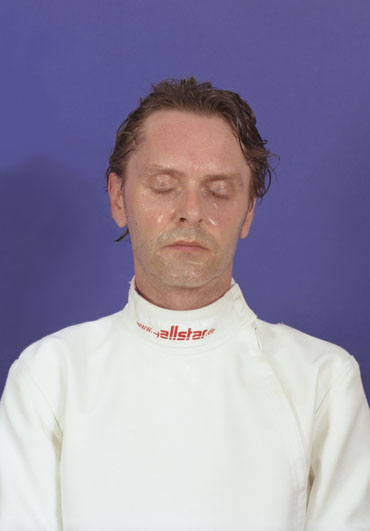 |

Foto: Staffan Redin |
 |
Staffan Redin FENCER
21 augusti - 25 september
"Ögonen dunkla sin kos, och synen molnar i mörkre". Hos Stiernhielm är ögats sakta skymning bilden av livets utslocknande. Vid varje blinkning erfar vi detta ridåfall även om det är hastigt som öppnandet av kamerans slutare. Utan ljus finns inget avklarnat eller materialiserat.
Bataille talar om våldsamheten i den akt när ögat vänds uppåt inåt i huvudet. Han menar att mörkret hos det inåtvända ögat inte är en frånvaro av ljus utan själva seendets process driven till sin yttersta spets, en okulär maximering där mörker och ljus inte längre står i ett dialektiskt förhållande till varandra. Inåtvändandet är totalt.
För en fäktare är det som ligger i synfältets periferi det primära genom att man lättare kan träffa en punkt om man inte fokuserar den. I videon Fencer kan man betrakta de ögonblickliga skiftningarna i blickens uttryck, ett spel med uttryck av attraktion och repellering.
I ett tidigare arbete om rodnaden har Staffan Redin studerat huden som en projektionsduk för våra inre sinnestillstånd.
I fotografierna av fäktare handlar det om ögonen som projektorer eller reflektorer av medvetandet och det flytande gränstillstånd av blick och icke-blick som utgörs av ett spänningsfält mellan hud och hornhinna. Den oseende blicken bakom ögonlocken kan visa att huvudsaken alltid är osynlig.
”Ögonen dunkla sin kos, och synen molnar i mörkre”
In Stiernhielms poetry the slow dusk of the eye is an image of life fading away.
At each blink we experience this fall of the curtain even if it is as fast as the shutter
of the camera. Without light there is nothing clear or materialised. Bataille speaks of the violence in the act when the eye turns upwards into the head. The darkness of the upturned eye is not the absence of light but the process of seeing taken to its limit. When darkness and light are no longer in a dialectic opposition. When inversion is complete and total.
A fencer has a better chance of hitting the target if it is in the periphery of the field of vision and not in the focus of it. In the video Fencer one can see the instantaneous and constant shiftings in the expressions of the eye, a play with attraction and repulsion.
In an earlier work on blushing Staffan Redin investigated how the skin can become a projection canvas for our inner emotions and states of mind. In these photographs of fencers he studies how the eyes can be seen as projectors or reflectors of our mind and the clouded borderline state of gaze and non-gaze that creates a field of tension between skin and cornea.
The unseeing gaze behind the eyelids can show that the most important is always invisible.
|
|  |
|









